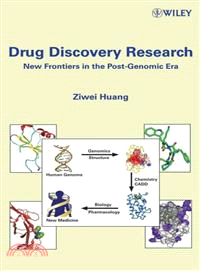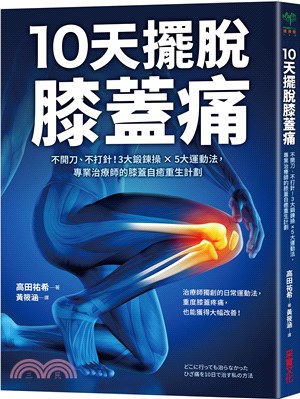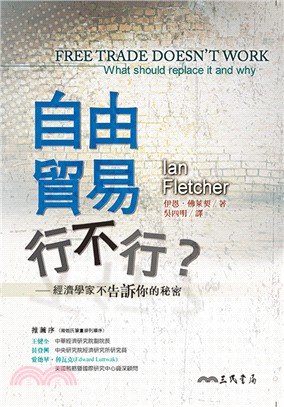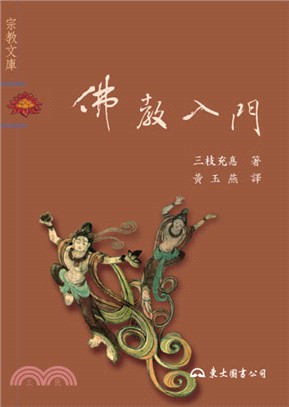Drug Discovery Research: New Frontiers In The Post-Genomic Era
商品資訊
定價
:NT$ 9673 元優惠價
:90 折 8706 元
若需訂購本書,請電洽客服 02-25006600[分機130、131]。
相關商品
商品簡介
作者簡介
名人/編輯推薦
目次
商品簡介
Post Genomics Drug Discovery and Research explores and discusses some of the most important topics in post-genomics life and biopharmaceutical sciences. It provides an introduction to the field, outlining examples of many techniques currently used, as well as those still under development, which are important for the research of biopharmaceutical discovery in the post-genomics era.
Integrates several developing and cutting-edge technologies and methods like bioinformatics, experimental therapeutics, and molecular recognition
Includes discussion on topics such as: computer-aided ligand design; peptide and protein chemistry and synthesis; synthesis of active natural products; and the use of emerging technologies like proteomics, nanotechnology, or bioengineering.
Integrates several developing and cutting-edge technologies and methods like bioinformatics, experimental therapeutics, and molecular recognition
Includes discussion on topics such as: computer-aided ligand design; peptide and protein chemistry and synthesis; synthesis of active natural products; and the use of emerging technologies like proteomics, nanotechnology, or bioengineering.
作者簡介
Ziwei Huang, PHD, is Professor at the Burnham Institute for Medical Research and Adjunct Professor at the University of California at San Diego. He was previously Assistant Professor at Thomas Jefferson University in Philadelphia (1995-2000) and tenured Associate Professor at the University of Illinois at Urbana-Champaign (2000-2004). The author or coauthor of numerous publications and patents, Professor Huang has conducted research in cross-disciplinary areas related to drug discovery, medicinal chemistry, biochemistry, and chemical biology and has developed novel therapeutic agents and research probes for treating or studying human diseases. He has organized many international conferences and workshops in drug discovery research in America and Asia. Additionally, Professor Huang has had close interaction with the biotechnology and pharmaceutical industries as the founder of several biopharmaceutical companies and consultant for many major biotechnology and pharmaceutical companies.
名人/編輯推薦
"A valuable resource for scientists … Chapters in each section are filled with in-depth biological and chemical data and, importantly, include worked examples of drugs identified from these approaches." (The Biochemist, October 2008)
"..the book achieves the objective of the Editor in providing a useful tool and reference for scientists concerned with state-of-the-art postgenomic drug discovery…this book will be of interest to medicinal chemistry, as well as to other concerned with developing new drug products." (Journal of Medicinal Chemistry, January 2008)
"..the book achieves the objective of the Editor in providing a useful tool and reference for scientists concerned with state-of-the-art postgenomic drug discovery…this book will be of interest to medicinal chemistry, as well as to other concerned with developing new drug products." (Journal of Medicinal Chemistry, January 2008)
目次
FOREWORD.
INTRODUCTION.
CONTRIBUTORS.
PART I. COMPUTATIONAL AND STRUCTURAL APPROACHES IN DRUG DISCOVERY.
CHAPTER 1. MOLECULAR DOCKING AND STRUCTURE-BASED DESIGN (P. Therese Lang, University of California, San Francisco, CA; Tiba Aynechi, University of California, San Francisco, CA; Demetri Moustakas, University of California, Berkeley, CA; Brian Shoichet, Irwin D. Kuntz,* University of California, San Francisco, CA; Natasja Brooijmans, University of California, San Francisco, CA; and Connie M. Oshiro, Roche, Palo Alto, CA).
CHAPTER 2. RECENT ADVANCES IN DRUG DISCOVERY RESEARCH USING STRUCTURE-BASED VIRTUAL SCREENING TECHNIQUES: EXAMPLES OF SUCCESS FOR DIVERSE PROTEIN TARGETS (Sutapa Ghosh (Burnham Institute for Medical Research La Jolla, CA), Aihua Nie (Burnham Institute for Medical Research La Jolla, CA), Jing An (Burnham Institute for Medical Research La Jolla, CA), and Ziwei Huang* (University of California, San Diego; Burnham Institute for Medical Research La Jolla, CA).
CHAPTER 3. VIRTUAL SCREENING IN DRUG DISCOVERY (Malcolm J. McGregor, Zhaowen Luo, and Xuliang Jiang* (Serono Research Institute, Rockland, MA).
CHAPTER 4. COMPUTER-AIDED DRUG DESIGN (Grace Shiahuy Chen, Providence University, Shalu, Taiwan, Republic of China and Ji-Wang Chern,* National Taiwan University, Taipei, Taiwan, Republic of China).
CHAPTER 5. FOCUSED LIBRARY DESIGN BASED ON HIT AND TARGET STRUCTURES: METHOD AND APPLICATION IN DRUG DISCOVERY (Weiliang Zhu (Shanghai Institute ofMateriaMedica, Chinese Academy of Sciences, Shanghai, P.R. China), Jian Li (Shanghai Institute ofMateriaMedica, Chinese Academy of Sciences, Shanghai, P.R. China), Zhen Gong (Shanghai Institute ofMateriaMedica, Chinese Academy of Sciences, Shanghai, P.R. China), Hong Liu (Shanghai Institute ofMateriaMedica, Chinese Academy of Sciences, Shanghai, P.R. China), and Hualiang Jiang* (Shanghai Institute ofMateriaMedica, Chinese Academy of Sciences, Shanghai, P.R. China, East China University of Science and Technology, Shanghai, P.R. China).
PART II. CHEMICAL AND SYNTHETIC APPROACHES IN DRUG DISCOVERY.
CHAPTER 6. BEYOND NATURAL PRODUCTS: SYNTHETIC ANALOGUES OF BRYOSTATIN 1 (Paul A. Wender*, Jeremy L. Baryza, Michael K. Hilinski, Joshua C. Horan, Cindy Kan, and Vishal A. Verma (Stanford University, Stanford, CA).
CHAPTER 7. THE PROMISES AND PITFALLS OF SMALL-MOLECULE INHIBITION OF POLY(ADP-RIBOSE) GLYCOHYDROLASE (PARG) (Amanda C. Nottbohm and Paul J. Hergenrother* (University of Illinois at Urbana-Champaign, Urbana, IL).
CHAPTER 8. CYCLIC ADP-RIBOSE ANALOGUES WITH MINIMAL STRUCTURE: SYNTHESIS AND CALCIUM-RELEASE ACTIVITY (Lihe Zhang* (Peking University, Beijing, P.R. China) and Andreas H. Guse (University Hospital Hamburg—Eppendorf, Institute of Biochemistry and Molecular Biology, Hamburg, Germany).
CHAPTER 9. EVALUATION OF NEUROIMMUNOPHILIN LIGANDS (Junhai Xiao, Aihua Nie, and Song Li* (Beijing Institute of Pharmacology and Toxicology, Beijing, P.R. China).
CHAPTER 10. CHIRAL DRUGS AND THE ASSOCIATED ASYMMETRIC SYNTHESIS (Jiange Zhang (Zhengzhou University, Zhengzhou, P.R. China) and Guoqiang Lin* (Shanghai Institute of Organic Chemistry, Chinese Academy of Sciences, Shanghai, P.R. China).
CHAPTER 11. ALPHA-HELIX MIMETICS IN DRUG DISCOVERY 281
Hang Yin, Gui-In Lee, and Andrew D. Hamilton*
Yale University, New Haven, CT
CHAPTER 12. BASIC AND TRANSLATIONAL RESEARCH OF CHEMOKINE LIGANDS AND RECEPTORS AND DEVELOPMENT OF NOVEL THERAPEUTICS (Won-Tak Choi, University of Illinois at Urbana-Champaign, Urbana, IL; Yohichi Kumaki, Raylight Corporation, Chemokine Pharmaceutical Inc., La Jolla, CA; I. M. Krishna Kumar, Burnham Institute for Medical Research, La Jolla, CA; Jing An, Burnham Institute for Medical Research, La Jolla, CA; Douglas D. Richman, Department of Molecular Pathology, University of California, San Diego, CA; Joseph G. Sodroski, Dana-Farber Cancer Institute, Harvard Medical School, Boston, MA; and Ziwei Huang,* University of Illinois at Urbana-Champaign, Urbana, IL, Burnham Institute for Medical Research, La Jolla, CA; Department of Molecular Pathology, University of California, San Diego, CA).
CHAPTER 13. RESEARCH PROGRESS IN PROTEIN POST-TRANSLATIONAL MODIFICATION (Jia Hu, Yanting Guo, and Yanmei Li,* Tsinghua University, Beijing, P.R. China).
CHAPTER 14. CONTROLLED RELEASE OFANTIBIOTICS ENCAPSULATED IN NANOPOROUS SOL–GEL MATERIALS WITH TUNABLE PORE PARAMETERS (Houping Yin, Laura Zheng, and Yen Wei,* Drexel University, Philadelphia, PA).
PART III. BIOLOGICAL APPROACHES AND TRANSLATIONAL RESEARCH IN DRUG DISCOVERY.
CHAPTER 15. RETINOIC ACID AND ARSENIC TRIOXIDE TREATMENT IN ACUTE PROMYELOCYTIC LEUKEMIA: A MODEL OF ONCOPROTEIN TARGETED THERAPY (Jian-Hua Tong, Sai-Juan Chen, and Zhu Chen,* Shanghai Institute of Hematology, Rui Jin Hospital, School of Medicine, Shanghai Jiao Tong University, Shanghai, P.R. China).
CHAPTER 16. 2-CHLORODEOXYADENOSINE (CLADRIBINE): RATIONAL DEVELOPMENT OFA NOVEL CHEMOTHERAPEUTIC AGENT (Howard B. Cottam and Dennis A. Carson,* Moores Cancer Center, University of California, San Diego, CA).
CHAPTER 17. APOPTOSIS-BASED DRUG DISCOVERY FOR CANCER (John C. Reed*, Dayong Zhai, Marc Hyer, and Kate Welsh, Burnham Institute for Medical Research, La Jolla, CA).
CHAPTER 18. MECHANISM-BASED DEVELOPMENT OF MEMANTINE AS A THERAPEUTIC AGENT IN TREATING ALZHEIMER’S DISEASE AND OTHER NEUROLOGIC DISORDERS: LOW-AFFINITY, UNCOMPETITIVE ANTAGONISM WITH FAST OFF-RATE (Huei-Sheng Vincent Chen*, and Stuart A. Lipton,* Burnham Institute for Medical Research, La Jolla, CA; University of California, San Diego, CA).
CHAPTER 19. BRIDGING BENCH TO CLINIC: ROLES OFANIMAL MODELS FOR POST-GENOMICS DRUG DISCOVERY ON METABOLIC DISEASES (Chi-Wai Wong and Ling Chen,* Guangzhou Institute of Biomedicine and Health, Chinese Academy of Sciences, Guangzhou, P.R. China).
CHAPTER 20. STEM CELL RESEARCH AND APPLICATIONS FOR HUMAN THERAPIES (Prithi Rajan, Kook In Park, Vaclav Ourednik, Jean Pyo Lee, Jamie Imitola, Franz-Joseph Mueller, Yang D. Teng, and Evan Snyder,* Burnham Institute for Medical Research, La Jolla, CA).
INDEX.
INTRODUCTION.
CONTRIBUTORS.
PART I. COMPUTATIONAL AND STRUCTURAL APPROACHES IN DRUG DISCOVERY.
CHAPTER 1. MOLECULAR DOCKING AND STRUCTURE-BASED DESIGN (P. Therese Lang, University of California, San Francisco, CA; Tiba Aynechi, University of California, San Francisco, CA; Demetri Moustakas, University of California, Berkeley, CA; Brian Shoichet, Irwin D. Kuntz,* University of California, San Francisco, CA; Natasja Brooijmans, University of California, San Francisco, CA; and Connie M. Oshiro, Roche, Palo Alto, CA).
CHAPTER 2. RECENT ADVANCES IN DRUG DISCOVERY RESEARCH USING STRUCTURE-BASED VIRTUAL SCREENING TECHNIQUES: EXAMPLES OF SUCCESS FOR DIVERSE PROTEIN TARGETS (Sutapa Ghosh (Burnham Institute for Medical Research La Jolla, CA), Aihua Nie (Burnham Institute for Medical Research La Jolla, CA), Jing An (Burnham Institute for Medical Research La Jolla, CA), and Ziwei Huang* (University of California, San Diego; Burnham Institute for Medical Research La Jolla, CA).
CHAPTER 3. VIRTUAL SCREENING IN DRUG DISCOVERY (Malcolm J. McGregor, Zhaowen Luo, and Xuliang Jiang* (Serono Research Institute, Rockland, MA).
CHAPTER 4. COMPUTER-AIDED DRUG DESIGN (Grace Shiahuy Chen, Providence University, Shalu, Taiwan, Republic of China and Ji-Wang Chern,* National Taiwan University, Taipei, Taiwan, Republic of China).
CHAPTER 5. FOCUSED LIBRARY DESIGN BASED ON HIT AND TARGET STRUCTURES: METHOD AND APPLICATION IN DRUG DISCOVERY (Weiliang Zhu (Shanghai Institute ofMateriaMedica, Chinese Academy of Sciences, Shanghai, P.R. China), Jian Li (Shanghai Institute ofMateriaMedica, Chinese Academy of Sciences, Shanghai, P.R. China), Zhen Gong (Shanghai Institute ofMateriaMedica, Chinese Academy of Sciences, Shanghai, P.R. China), Hong Liu (Shanghai Institute ofMateriaMedica, Chinese Academy of Sciences, Shanghai, P.R. China), and Hualiang Jiang* (Shanghai Institute ofMateriaMedica, Chinese Academy of Sciences, Shanghai, P.R. China, East China University of Science and Technology, Shanghai, P.R. China).
PART II. CHEMICAL AND SYNTHETIC APPROACHES IN DRUG DISCOVERY.
CHAPTER 6. BEYOND NATURAL PRODUCTS: SYNTHETIC ANALOGUES OF BRYOSTATIN 1 (Paul A. Wender*, Jeremy L. Baryza, Michael K. Hilinski, Joshua C. Horan, Cindy Kan, and Vishal A. Verma (Stanford University, Stanford, CA).
CHAPTER 7. THE PROMISES AND PITFALLS OF SMALL-MOLECULE INHIBITION OF POLY(ADP-RIBOSE) GLYCOHYDROLASE (PARG) (Amanda C. Nottbohm and Paul J. Hergenrother* (University of Illinois at Urbana-Champaign, Urbana, IL).
CHAPTER 8. CYCLIC ADP-RIBOSE ANALOGUES WITH MINIMAL STRUCTURE: SYNTHESIS AND CALCIUM-RELEASE ACTIVITY (Lihe Zhang* (Peking University, Beijing, P.R. China) and Andreas H. Guse (University Hospital Hamburg—Eppendorf, Institute of Biochemistry and Molecular Biology, Hamburg, Germany).
CHAPTER 9. EVALUATION OF NEUROIMMUNOPHILIN LIGANDS (Junhai Xiao, Aihua Nie, and Song Li* (Beijing Institute of Pharmacology and Toxicology, Beijing, P.R. China).
CHAPTER 10. CHIRAL DRUGS AND THE ASSOCIATED ASYMMETRIC SYNTHESIS (Jiange Zhang (Zhengzhou University, Zhengzhou, P.R. China) and Guoqiang Lin* (Shanghai Institute of Organic Chemistry, Chinese Academy of Sciences, Shanghai, P.R. China).
CHAPTER 11. ALPHA-HELIX MIMETICS IN DRUG DISCOVERY 281
Hang Yin, Gui-In Lee, and Andrew D. Hamilton*
Yale University, New Haven, CT
CHAPTER 12. BASIC AND TRANSLATIONAL RESEARCH OF CHEMOKINE LIGANDS AND RECEPTORS AND DEVELOPMENT OF NOVEL THERAPEUTICS (Won-Tak Choi, University of Illinois at Urbana-Champaign, Urbana, IL; Yohichi Kumaki, Raylight Corporation, Chemokine Pharmaceutical Inc., La Jolla, CA; I. M. Krishna Kumar, Burnham Institute for Medical Research, La Jolla, CA; Jing An, Burnham Institute for Medical Research, La Jolla, CA; Douglas D. Richman, Department of Molecular Pathology, University of California, San Diego, CA; Joseph G. Sodroski, Dana-Farber Cancer Institute, Harvard Medical School, Boston, MA; and Ziwei Huang,* University of Illinois at Urbana-Champaign, Urbana, IL, Burnham Institute for Medical Research, La Jolla, CA; Department of Molecular Pathology, University of California, San Diego, CA).
CHAPTER 13. RESEARCH PROGRESS IN PROTEIN POST-TRANSLATIONAL MODIFICATION (Jia Hu, Yanting Guo, and Yanmei Li,* Tsinghua University, Beijing, P.R. China).
CHAPTER 14. CONTROLLED RELEASE OFANTIBIOTICS ENCAPSULATED IN NANOPOROUS SOL–GEL MATERIALS WITH TUNABLE PORE PARAMETERS (Houping Yin, Laura Zheng, and Yen Wei,* Drexel University, Philadelphia, PA).
PART III. BIOLOGICAL APPROACHES AND TRANSLATIONAL RESEARCH IN DRUG DISCOVERY.
CHAPTER 15. RETINOIC ACID AND ARSENIC TRIOXIDE TREATMENT IN ACUTE PROMYELOCYTIC LEUKEMIA: A MODEL OF ONCOPROTEIN TARGETED THERAPY (Jian-Hua Tong, Sai-Juan Chen, and Zhu Chen,* Shanghai Institute of Hematology, Rui Jin Hospital, School of Medicine, Shanghai Jiao Tong University, Shanghai, P.R. China).
CHAPTER 16. 2-CHLORODEOXYADENOSINE (CLADRIBINE): RATIONAL DEVELOPMENT OFA NOVEL CHEMOTHERAPEUTIC AGENT (Howard B. Cottam and Dennis A. Carson,* Moores Cancer Center, University of California, San Diego, CA).
CHAPTER 17. APOPTOSIS-BASED DRUG DISCOVERY FOR CANCER (John C. Reed*, Dayong Zhai, Marc Hyer, and Kate Welsh, Burnham Institute for Medical Research, La Jolla, CA).
CHAPTER 18. MECHANISM-BASED DEVELOPMENT OF MEMANTINE AS A THERAPEUTIC AGENT IN TREATING ALZHEIMER’S DISEASE AND OTHER NEUROLOGIC DISORDERS: LOW-AFFINITY, UNCOMPETITIVE ANTAGONISM WITH FAST OFF-RATE (Huei-Sheng Vincent Chen*, and Stuart A. Lipton,* Burnham Institute for Medical Research, La Jolla, CA; University of California, San Diego, CA).
CHAPTER 19. BRIDGING BENCH TO CLINIC: ROLES OFANIMAL MODELS FOR POST-GENOMICS DRUG DISCOVERY ON METABOLIC DISEASES (Chi-Wai Wong and Ling Chen,* Guangzhou Institute of Biomedicine and Health, Chinese Academy of Sciences, Guangzhou, P.R. China).
CHAPTER 20. STEM CELL RESEARCH AND APPLICATIONS FOR HUMAN THERAPIES (Prithi Rajan, Kook In Park, Vaclav Ourednik, Jean Pyo Lee, Jamie Imitola, Franz-Joseph Mueller, Yang D. Teng, and Evan Snyder,* Burnham Institute for Medical Research, La Jolla, CA).
INDEX.
主題書展
更多
主題書展
更多書展本週66折
您曾經瀏覽過的商品
購物須知
外文書商品之書封,為出版社提供之樣本。實際出貨商品,以出版社所提供之現有版本為主。部份書籍,因出版社供應狀況特殊,匯率將依實際狀況做調整。
無庫存之商品,在您完成訂單程序之後,將以空運的方式為你下單調貨。為了縮短等待的時間,建議您將外文書與其他商品分開下單,以獲得最快的取貨速度,平均調貨時間為1~2個月。
為了保護您的權益,「三民網路書店」提供會員七日商品鑑賞期(收到商品為起始日)。
若要辦理退貨,請在商品鑑賞期內寄回,且商品必須是全新狀態與完整包裝(商品、附件、發票、隨貨贈品等)否則恕不接受退貨。
























